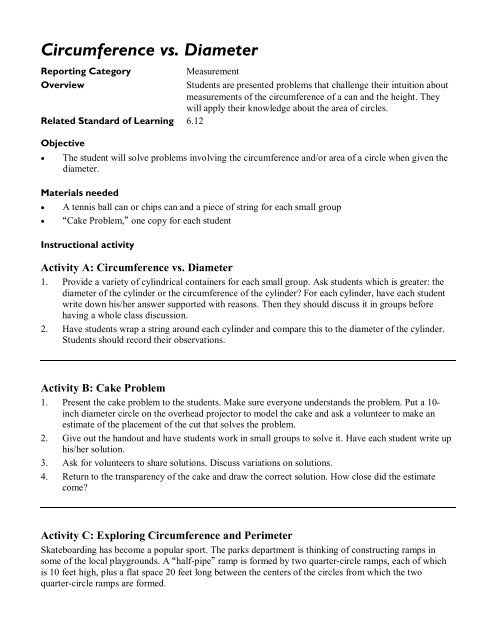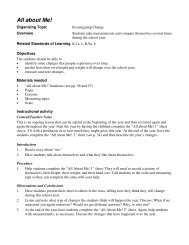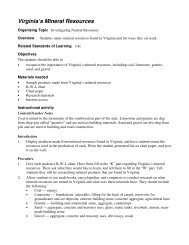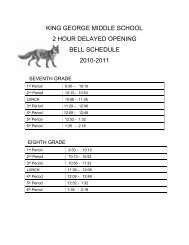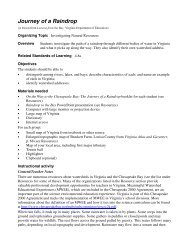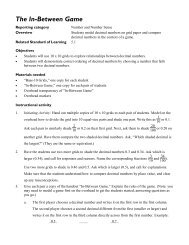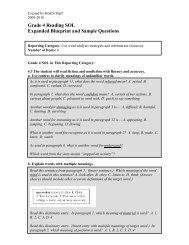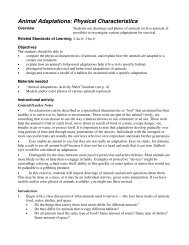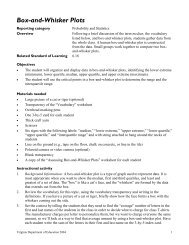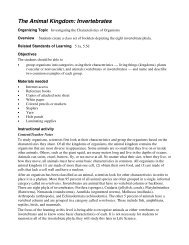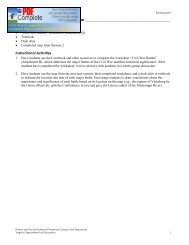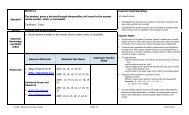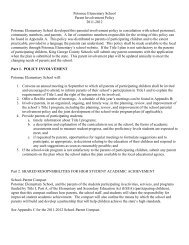Circumference vs. Diameter
Circumference vs. Diameter
Circumference vs. Diameter
You also want an ePaper? Increase the reach of your titles
YUMPU automatically turns print PDFs into web optimized ePapers that Google loves.
<strong>Circumference</strong> <strong>vs</strong>. <strong>Diameter</strong><br />
Reporting Category<br />
Measurement<br />
Overview<br />
Students are presented problems that challenge their intuition about<br />
measurements of the circumference of a can and the height. They<br />
will apply their knowledge about the area of circles.<br />
Related Standard of Learning 6.12<br />
Objective<br />
· The student will solve problems involving the circumference and/or area of a circle when given the<br />
diameter.<br />
Materials needed<br />
· A tennis ball can or chips can and a piece of string for each small group<br />
· Cake Problem, one copy for each student<br />
Instructional activity<br />
Activity A: <strong>Circumference</strong> <strong>vs</strong>. <strong>Diameter</strong><br />
1. Provide a variety of cylindrical containers for each small group. Ask students which is greater: the<br />
diameter of the cylinder or the circumference of the cylinder? For each cylinder, have each student<br />
write down his/her answer supported with reasons. Then they should discuss it in groups before<br />
having a whole class discussion.<br />
2. Have students wrap a string around each cylinder and compare this to the diameter of the cylinder.<br />
Students should record their observations.<br />
Activity B: Cake Problem<br />
1. Present the cake problem to the students. Make sure everyone understands the problem. Put a 10-<br />
inch diameter circle on the overhead projector to model the cake and ask a volunteer to make an<br />
estimate of the placement of the cut that solves the problem.<br />
2. Give out the handout and have students work in small groups to solve it. Have each student write up<br />
his/her solution.<br />
3. Ask for volunteers to share solutions. Discuss variations on solutions.<br />
4. Return to the transparency of the cake and draw the correct solution. How close did the estimate<br />
come?<br />
Activity C: Exploring <strong>Circumference</strong> and Perimeter<br />
Skateboarding has become a popular sport. The parks department is thinking of constructing ramps in<br />
some of the local playgrounds. A half-pipe ramp is formed by two quarter-circle ramps, each of which<br />
is 10 feet high, plus a flat space 20 feet long between the centers of the circles from which the two<br />
quarter-circle ramps are formed.
B<br />
10 ft.<br />
10 ft.<br />
A<br />
20 ft.<br />
1. Find the distance a skateboarder travels from the top of one ramp to the top of the other. (Hint: What<br />
is the length of arc AB?)<br />
2. Another launch ramp is formed by 2 arcs, each with a central angle of 60 degrees and a radius of 10<br />
ft. Find the length from the top of one ramp to the top of the other. (Hint: What fractional part of the<br />
circle is each arc?)<br />
3. A third ramp is a straight ramp 4 ft. high and 10 ft. long with a flat space of 20 ft. Find the length of<br />
the ramps from point P to point R. (Hint: Use the Pythagorean Theorem)<br />
P<br />
X<br />
X<br />
R<br />
4 ft.<br />
4 ft.<br />
10 ft.<br />
20 ft. 10 ft.<br />
Sample assessment<br />
· A school track is formed by 2 straight segments joined by 2 half circles. Each segment is l long and<br />
each half-circle diameter is d in length. Write a formula for finding the distance, D, around the track.<br />
Follow-up/extension<br />
Soda Straws<br />
How many straws full of pineapple juice can be taken from a 46-fl.-oz. can of juice that is filled to the<br />
top?<br />
1. Measure to find the following:<br />
<strong>Diameter</strong> of the can: _________<br />
Height of the can: ___________<br />
<strong>Diameter</strong> of the straw: _________ Length of the straw: ___________<br />
2. Explain how you determined your answers.
Cake Problem<br />
Name:<br />
Date:<br />
You have a cake that is 10 inches in diameter. You expect 12 people to share it, so you cut it into 12 equal<br />
pieces (Figure A).<br />
Before you get a chance to serve the cake, 12 more people arrive! Therefore, you decide to cut a<br />
concentric circle in the cake so that you will have 24 pieces (Figure B).<br />
How far from the center of the cake should the circle cut be made so that all 24 people get the same<br />
amount of cake?<br />
Figure A<br />
Figure B


